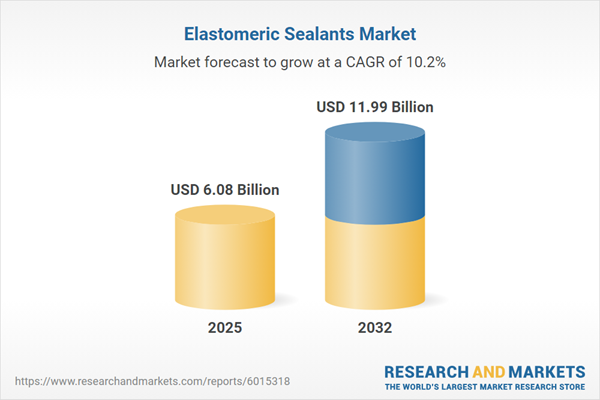Speak directly to the analyst to clarify any post sales queries you may have.
The elastomeric sealants market is evolving as a critical component in modern construction, automotive, and industrial sectors, where demand for resilient, high-performance materials capable of meeting stringent application requirements is on the rise.
Market Snapshot: Elastomeric Sealants Market Size and Growth Trajectory
The elastomeric sealants market grew from USD 5.51 billion in 2024 to USD 6.08 billion in 2025. It is expected to sustain robust momentum with a CAGR of 10.19%, reaching USD 11.99 billion by 2032. This upward trend is propelled by rapid infrastructure development, regulatory compliance strategies, and the introduction of sustainability-focused innovations across sectors worldwide. Market participants are increasingly prioritizing the adoption of advanced chemical formulations to align with evolving environmental standards and performance benchmarks.
Scope & Segmentation
- Type: Acrylic, Polysulfide, Polyurethane, Silicone, Silyl Modified Polymer
- End Use: Aerospace, Automotive (Aftermarket, OEM), Construction (Commercial, Infrastructure, Residential), Industrial, Marine
- Application: Expansion Joint, Insulation, Joint Sealing, Structural Glazing, Weatherproofing
- Packaging: Bulk, Cartridge (High-Temperature Cartridge, Low-VOC Cartridge, Standard Cartridge), Sausage, Tube
- Sales Channel: Direct Sales, Distribution Partner (Retailer, Wholesaler), E-Commerce
- Regions: Americas (North America—United States, Canada, Mexico; Latin America—Brazil, Argentina, Chile, Colombia, Peru), Europe, Middle East & Africa (Europe—United Kingdom, Germany, France, Russia, Italy, Spain, Netherlands, Sweden, Poland, Switzerland; Middle East—United Arab Emirates, Saudi Arabia, Qatar, Turkey, Israel; Africa—South Africa, Nigeria, Egypt, Kenya), Asia-Pacific (China, India, Japan, Australia, South Korea, Indonesia, Thailand, Malaysia, Singapore, Taiwan)
- Key Companies: Sika AG, RPM International Inc., Henkel AG & Co. KGaA, 3M Company, MAPEI S.p.A., H.B. Fuller Company, Wacker Chemie AG, The Dow Chemical Company, Fosroc International Limited, Arkema S.A.
Key Takeaways for Senior Decision-Makers
- Elastomeric sealants are increasingly integral to high-demand sectors due to their ability to maintain performance in challenging environments.
- Advancements in polymer science are enabling new use cases and supporting requirements for durability, flexibility, and environmental compliance.
- Digitalization is streamlining production and service delivery, with real-time monitoring improving batch consistency and predictive maintenance for end users.
- Supplier collaboration and co-innovation models are redefining product development pipelines and customizing solutions for sector-specific needs.
- Distribution channels, including direct, wholesale, and online platforms, shape how tailored solutions reach distinct end markets efficiently.
Tariff Impact: Navigating Shifts in Raw Material Sourcing and Costs
Recent United States tariffs have created significant cost pressures across the elastomeric sealant value chain, impacting essential raw materials such as specialty polymers and crosslinkers. The market response varies, with larger manufacturers leveraging joint ventures and long-term domestic sourcing, while smaller players explore alternative chemistries. These efforts are influencing supply chain structures, input stability, and inventory management practices as companies seek to maintain margin integrity.
Elastomeric Sealants Market: Methodology & Data Sources
This analysis employs a hybrid methodology, incorporating interviews with industry participants and technical experts alongside secondary research from regulatory, trade, and patent resources. Advanced statistical and triangulation techniques validate key findings and ensure robustness across both supply and demand perspectives. Scenario analysis was conducted to account for tariff adjustments, material access, and regulatory trends.
Why This Report Matters
- Supports decision-making with clear segmentation insights for resource allocation and product portfolio optimization.
- Equips leaders with intelligence on evolving regulatory expectations, guiding strategic alignment and risk mitigation.
- Delivers actionable data for addressing competitive dynamics and operational resilience in changing market conditions.
Conclusion
The elastomeric sealants market is advancing through material innovation, regulatory adaptation, and evolving supply chain strategies. This detailed research provides strategic direction for industry leaders pursuing competitive advantage and sustainable growth in an increasingly complex landscape.
Additional Product Information:
- Purchase of this report includes 1 year online access with quarterly updates.
- This report can be updated on request. Please contact our Customer Experience team using the Ask a Question widget on our website.
Table of Contents
3. Executive Summary
4. Market Overview
7. Cumulative Impact of Artificial Intelligence 2025
Companies Mentioned
The companies profiled in this Elastomeric Sealants market report include:- Sika AG
- RPM International Inc.
- Henkel AG & Co. KGaA
- 3M Company
- MAPEI S.p.A.
- H.B. Fuller Company
- Wacker Chemie AG
- The Dow Chemical Company
- Fosroc International Limited
- Arkema S.A.
Table Information
| Report Attribute | Details |
|---|---|
| No. of Pages | 186 |
| Published | October 2025 |
| Forecast Period | 2025 - 2032 |
| Estimated Market Value ( USD | $ 6.08 Billion |
| Forecasted Market Value ( USD | $ 11.99 Billion |
| Compound Annual Growth Rate | 10.1% |
| Regions Covered | Global |
| No. of Companies Mentioned | 11 |









